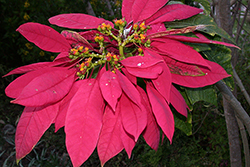e-Flora of Thailand
Volume 8 > Part 1 > Year 2005 > Page 281 > Euphorbiaceae > Euphorbia
14. Euphorbia pulcherrima Willd. ex Klotzschwfo-0000964275
Neue Allg. Deutsche Garten-Blumenzeitung 2: 27. 1834; Boiss. in DC., Prodr. 15(2): 71. 1862: Kurz, Forest Fl. Burma 2: 418. 1877; Ridl., Fl. Malay Penins. 3: 182. 1924; Gagnep. in Lecomte, Fl. Indo-Chine 5: 243. 1925; Burkill, Dict. Econ. Prod. Malay Pen. 1: 980. 1935; P.H.Hô, Câyco Viêtnam 2, 1: 357, pl. 4659. 1992; J.S.Ma, Fl. Reipubl. Popularis Sin. 44(3): 63, fig. 1–3, pl. 16. 1997.— Poinsettia pulcherrima (Willd. Ex Klotzsch) Graham, Edinb. New Philos. J. 20: 412. 1836; Bot. Mag. 63: t. 3493. Dec. 1836; R. L. Dressler, Ann. Missouri Bot. Gard. 48: 335. 1962.
Accepted Name : This is currently accepted.
Description : Shrub, 3 m high, dbh 8 cm, not to slightly branched, as seedling with a fleshy storage root; bark light brown, smooth, branchlets hollow. Indumentum consisting of pale-brownish hairs, to ca 1 mm long, loosely erect. Stipules as small scales, caducous. Leaves: petioles 5–7 cm long, subglabrous; alternate, green; blades ovate-elliptic and sometimes panduriformly lobed, ca 12–17 by 6–9 cm, chartaceous, base acute or obtuse with very base acute, margin entire, apex acuminate, glabrous above, slightly brighter and distinctly pubescent below; venation distinct, not triplinerved, with ca 16–17 pairs of sideveins. Cyathia grouped in an apical pseudo-umbel, glabrous, their bracts enlarged, leaflike, with a pedicel of 1–3 cm, narrower than stem-leaves, green with red midrib or completely red; peduncles 4–5 mm long; involucres ca 5 mm long; gland 1, ca 5 mm wide, without appendage; ovary with a pedicel of ca 3 mm; stigmas united into a style column of 1–5 mm, free stigmas completely bifid. Fruits not studied, but described as green, sulcate, with a somewhat fleshy pericarp. Seeds not studied, described as 10 mm long, smooth.
Thailand : Widely cultivated and often escaping, naturalizing at least in NORTHERN: Chiang Mai (Doi Suthep).
Distribution : Originating from Mexico (type), and now widely cultivated in tropical and subtropical regions around the earth.
Ecology : Escaped garden ornamental, along roadsides, originally (Mexico) found in tropical deciduous forests, ca 1,000 m alt. Flowering: January, February, September
Vernacular : Ban Bai (บานใบ)(Northern); khritsamat (คริสมาส)(Ratchaburi); pho phan (โพผัน), song radu (สองระดู)(Bangkok).
CommonName : Poinsettia.
Uses: Widely cultivated as ornamental. In Java the leaves are eaten as seasoning (Burkill, 1935).

